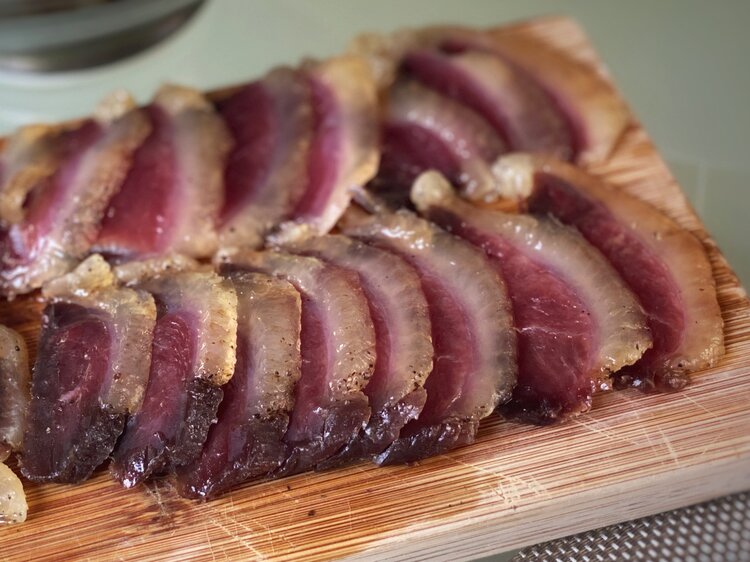Cured Magret
This recipe for cured duck breast (magret) is adapted from La Buvette: Recipes & Wine Notes from Paris, by Camille Fourmont and Kate Leahy. We reviewed the book in August 2020.
Fourmont and Leahy call for one large duck breast of about 12 ounces in their recipe, but they note that magrets in France are larger than those in the United States and you can also use two smaller breasts, about 5 to 6 ounces each. That’s what we did. It’s pretty amazing how easy these are to cure: Basically you coat them in salt, let them cure 12 hours, wipe off the salt and let them age in the refrigerator a couple weeks. The texture is similar to cured ham, and the flavor mellows to marvelousness. Fourmant calls for either kosher salt or coarse grey sea salt; I happened to have some excellent coarse grey sea salt from Guérande in France (which until recently I could pick up for a song at Cost Plus), and used that. You can find it on Amazon. Duck breasts may be purchased in well stocked supermarkets, or online at D’Artagnan.
Like any charcuterie, this cured magret is nice to serve with an aperitif. You could serve the slices with a sliced baguette or crackers; I like to put out toothpicks and savor the slices on their own. Fourmont likes to serve it alongside a sage butter. Plan to make this two or three weeks in advance.
Serves 6 to 8.
Ingredients
3 cups kosher salt or coarse grey sea salt
1 large duck breast (about 12 ounces) or two smaller breasts (about 5 or 6 ounces each)
1 teaspoon freshly ground black pepper
Instructions
1. Put 2 cups of the salt in a container that will fit the duck (try a loaf pan for one breast or a rectangular glass baking dish for two smaller breasts). Place the duck on top, then pour the rest of the salt over the duck so it is completely covered. Refrigerate and let the meat cure for 12 hours.
2. Pull the duck out of the salt, wipe off the excess and discard the salt. Season the duck with the pepper and then wrap each breast in a clean, dry kitchen towel (don’t use terrycloth; a thinner cloth works better). Put the wrapped duck on a plate and place on the top shelf of the refrigerator. Let it cure until firm and dry to the touch, 2 to 3 weeks. Check on it periodically to make sure it’s not moldy; if it gets a little mold, wipe it with a clean cloth. When ready, it should give slightly when pressed.
3. To serve, use a sharp knife to slice the breast crosswise, against the grain, into thin slices. (It is easier to slice when cold but better to eat when at room temperature.) Keep any unsliced duck tightly wrapped in parchment paper in the refrigerator so it can breathe. The cured breast keeps for up to 1 month, but it will continue to dry out the longer you keep it. If you like it tender, it’s probably best to eat it within a week or 10 days.

Cured Magret
Ingredients
- 3 cups kosher salt or coarse grey sea salt
- 1 large duck breast (about 12 ounces) or two smaller breasts (about 5 or 6 ounces each)
- 1 teaspoon freshly ground black pepper
Instructions
- Put 2 cups of the salt in a container that will fit the duck (try a loaf pan for one breast or a rectangular glass baking dish for two smaller breasts). Place the duck on top, then pour the rest of the salt over the duck so it is completely covered. Refrigerate and let the meat cure for 12 hours.
- Pull the duck out of the salt, wipe off the excess and discard the salt. Season the duck with the pepper and then wrap each breast in a clean, dry kitchen towel (don’t use terrycloth; a thinner cloth works better). Put the wrapped duck on a plate and place on the top shelf of the refrigerator. Let it cure until firm and dry to the touch, 2 to 3 weeks. Check on it periodically to make sure it’s not moldy; if it gets a little mold, wipe it with a clean cloth. When ready, it should give slightly when pressed.
- To serve, use a sharp knife to slice the breast crosswise, against the grain, into thin slices. (It is easier to slice when cold but better to eat when at room temperature.) Keep any unsliced duck tightly wrapped in parchment paper in the refrigerator so it can breathe. The cured breast keeps for up to 1 month, but it will continue to dry out the longer you keep it. If you like it tender, it’s probably best to eat it within a week or 10 days.
Notes:
RECIPE NOTES
• We used two smaller breasts; one was about 5 ounces and the other was 6, and used coarse grey sea salt to cure them. They were ready in 2 1/2 weeks.
• There is no mention of duck possibly getting moldy in the recipe itself. I contacted Fourmont to ask why a thin cloth was better, and whether to wrap it tightly or loosely, and she happened to mention that one should check for mold. Her answer to the loose versus tight question: “It doesn’t matter that much. Just have a look at it regularly, so you can also check if it gets a bit moldy.” If it does, she says, “clean it with a clean fabric.”




